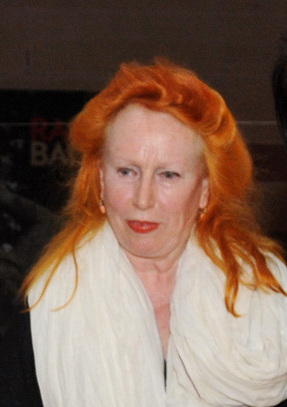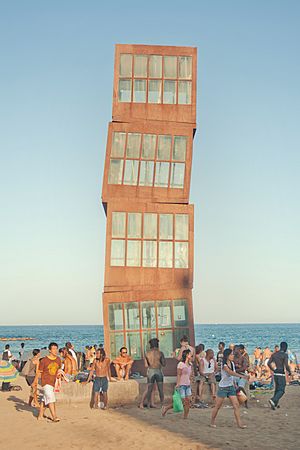Rebecca Horn facts for kids
Quick facts for kids
Rebecca Horn
|
|
|---|---|

Horn in 2012
|
|
| Born | 24 March 1944 Michelstadt, Gau Hesse-Nassau, Germany
|
| Died | 6 September 2024 (aged 80) |
| Nationality | German |
| Education | Hochschule für bildende Künste Hamburg (1964–1970) |
| Known for | Sculpture, installation art, performance art, and film |
Rebecca Horn (born March 24, 1944 – died September 6, 2024) was a famous German artist. She was known for her unique installation art, directing films, and creating special "body modifications." One of her most famous works was Einhorn (Unicorn), a suit with a large horn sticking up from the head.
Rebecca Horn also directed several films, including Der Eintänzer (1978), La ferdinanda: Sonate für eine Medici-Villa (1982), and Buster's Bedroom (1990). She lived and worked in both Paris and Berlin.
Contents
Early Life and Art School
Rebecca Horn was born in Michelstadt, Germany, on March 24, 1944. Her Romanian governess taught her how to draw. Living in Germany after World War II ended made her love drawing even more. She once said, "We could not speak German. Germans were hated. We had to learn French and English. We were always traveling somewhere else, speaking something else. But I had a Romanian governess who taught me how to draw. I did not have to draw in German or French or English. I could just draw."
Rebecca spent much of her childhood in boarding schools. When she was 19, she decided to study art instead of economics, which her parents wanted. In 1963, she started at the Hochschule für bildende Künste Hamburg (Hamburg Academy of Fine Arts).
A year later, she had to leave art school because she became very sick from working with glass fiber without a mask. She spent a year recovering in a sanatorium. After getting better, Horn started using soft materials for her sculptures. Her illness and long recovery greatly influenced her art.
Exploring Art: Rebecca Horn's Work
Rebecca Horn became well-known in the 1980s as part of a new group of German artists. She created body art, but also worked in many other ways. These included performance art, installation art, sculpture, and film. She also wrote poetry, which sometimes inspired her art or was influenced by it.
When Horn returned to the Hamburg academy, she continued to make art that looked like cocoons. She used padded body extensions and special bandages. In the late 1960s, she began creating performance art, often using these body extensions.
Body Sculptures: Art on the Body
In 1968, Rebecca Horn made her first body sculptures. These were objects and tools attached to the human body. Her goal was to explore how a person connects with their surroundings.
Einhorn (Unicorn) is one of her most famous performance pieces. It features a long horn worn on her head, which is a clever play on her name. She showed Einhorn at the 1972 Documenta art show. The piece shows a young woman walking through a field and forest. She wears only the white horn, held by straps similar to those in Frida Kahlo's painting Broken Column. The image mixes old myths with modern ideas.
Pencil Mask is another body extension piece. It has straps that hold pencils near the face. When the person moves their face against a wall, the pencils make marks that show their movements.
Finger Gloves (1972) was a performance piece where she wore gloves with long extensions made of balsa wood and cloth. These extensions made her feel as if her fingers were longer. She felt like she was touching things that the extensions were touching. A similar piece from her Berlin Exercises (1974) series was called "Scratching Both Walls at Once." For this, she made finger extension gloves that were exactly the right length. If a person stood in the middle of a room, they could touch both opposite walls at the same time.
Another piece about touch and feeling is Feather Fingers (1972). A feather is attached to each finger with a metal ring. This makes the hand feel as light and sensitive as a bird's wing. When she touched her other arm with these feather fingers, it created a strange feeling. She described it as if her hands became "two utterly unrelated beings," causing "contradictory sensations." This artwork really focused on how sensitive our sense of touch can be.
Sculpture: Moving Art and Big Works
Rebecca Horn continued to use feathers in her art during the 1970s and 1980s. Many of her feathered pieces would wrap around a person like a cocoon. Others worked as masks or fans, covering or enclosing the body. Examples include Cockfeather (1971), Cockfeather Mask (1973), Cockatoo Mask (1973), and Paradise Widow (1975).
In the 1980s, Horn started creating "machines" in her art. For example, in The Little Painting School Performs a Waterfall (1988), she made a machine that painted like a human. Three fan-shaped paint brushes on metal arms slowly dipped into blue and green paint. Then they snapped back, splashing paint onto the wall, ceiling, floor, and canvases below. This cycle repeated until the canvases were covered.
In the 1990s, Horn created impressive sculptures for important historical places. These included the Tower of the Nameless in Vienna (1994) and Concert for Buchenwald in Weimar (1999). For Concert for Buchenwald, she used 40-meter-long walls of ashes behind glass. This represented a kind of archive.
She also explored the idea of energy in places with installations like High Moon, New York (1991) and El Reio de la Luna, Barcelona (1992). For the 1992 Olympics in Barcelona, Horn was asked to create the steel sculpture L'Estel Ferit.
Many of Horn's works also explored the idea of lenses. A large tinted lens might seem to offer protection, but it also draws attention to what's behind it. Her installation for Taipei 101, Dialogue between Yin and Yang (2002), explored this idea. It used binoculars and mirrors to show the passive and active energies of Yin and yang.
Film: Bringing Art to the Screen
Rebecca Horn spent over ten years in New York making long films. She used the sculptures and movements from her earlier art in these films, giving them new meaning.
Her first full-length film was Der Eintänzer (1978), which was about a young man, a blind man, and twins. Later films include La Ferdinanda: Sonata for a Medici Villa and Buster's Bedroom. La Ferdinanda is in German, while the others are in English. In all her films, Horn showed her interest in imperfect bodies and the balance between people and objects. She worked with artist Jannis Kounellis and also collaborated with German writer Martin Mosebach on the screenplays for Buster's Bedroom and Roussel. Buster's Bedroom (1990) was filmed by the famous Sven Nykvist and starred actors like Donald Sutherland and Geraldine Chaplin.
Some of Horn's moving sculptures appeared in her films. For example, The Feathered Prison Fan (1978), a large fan big enough to hold an adult, was in Der Eintänzer. The Peacock Machine (1979–80), which folds and unfolds beautiful white peacock feathers, was in La Ferdinanda.
Other Projects and Exhibitions
Rebecca Horn is the subject of a book called The Glance of Infinity. In 2008 and 2009, she mentored Japanese artist Masanori Handa through a special arts program.
Rebecca Horn was not very well known when she was invited to the 1972 Documenta art show in Kassel. She was only 28 years old. Her first solo art show was in West Berlin in 1973. Since then, she has shown her work at major events like the Venice Biennale and the Biennale of Sydney. She is one of the few artists chosen to be part of Documenta four times.
Her solo show at the Museum of Contemporary Art, Los Angeles, called "Rebecca Horn: Diving through Buster's Bedroom," featured 18 large moving sculptures. These sculptures were connected to the ideas and story of her film, Buster's Bedroom. In 1993, the Solomon R. Guggenheim Museum in New York held a big show of her work. This show then traveled to several other museums around the world. In 2005, the Hayward Gallery in London also held a large show of her art.
Personal Life
Rebecca Horn lived in Hamburg until 1971, and then briefly in London. In 1973, she moved to Berlin. She also lived in Paris and New York. She was a Buddhist.
Rebecca Horn passed away on September 6, 2024, at the age of 80.
Public Collections
Rebecca Horn's art can be found in many important public collections around the world, including:
- Harvard Art Museums, Cambridge
- Solomon R. Guggenheim Museum, New York
- The Museum of Modern Art, New York
- Museum of Contemporary Art, Los Angeles
- San Francisco Museum of Modern Art, San Francisco
- Art Gallery of New South Wales, Australia
- Castello di Rivoli Museum of Contemporary Art, Turin, Italy
- Tate Gallery, London
- Centre Georges Pompidou, Paris
- Centre for International Light Art (CILA), Unna, Germany
- Zentrum für Kunst und Medientechnologie, Karlsruhe, Germany
- Stedelijk Museum, Amsterdam
- Van Abbemuseum, Eindhoven
- Walker Art Center
Recognition and Awards
In 1988, Rebecca Horn won the Carnegie Prize for her installation The Hyra Forest/Performing: Oscar Wilde. In 1992, she became the first woman to receive the important Goslarer Kaiserring award. She also won the Medienkunstpreis Karlsruhe for her achievements in technology and art. Later, she received the 2010 Praemium Imperiale in Sculpture and the Grande Médaille des Arts Plastiques 2011 from the Académie d’Architecture de Paris. In 2012, Horn was given the Austrian Decoration for Science and Art. She was also a member of the order Pour le Mérite.
See also
 In Spanish: Rebecca Horn para niños
In Spanish: Rebecca Horn para niños
- List of German women artists


